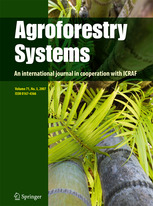
Abstract
Enteric methane (CH4) emission from ruminant livestock is one of the main sources of greenhouse gases from the agricultural sector worldwide. In tropical regions there is a wide variety of forage species that have the capacity to improve cattle diets and reduce enteric CH4 emissions. A screening trial was conducted to investigate the nutrient and phytochemical composition, total gas and CH4 production of fifteen tropical multipurpose forage species from Southern Mexico. The content of crude protein (CP), neutral detergent fiber (NDF) and gross energy fluctuated among species, from 99.07 to 264.4, from 275.19 to 614.35 g kg−1 dry matter (DM) and from 15.65 to 20.92 MJ kg−1 DM. In vitro digestibility of DM (IVDDM) was lower for the species containing condensed tannins (CT) and fluctuated between 447.44 and 709.94 g kg−1 DM. Bursera simaruba showed the lowest CH4 production (9.077 mg g−1 degraded organic matter) with a CT content of 200 g kg−1 DM. Results suggest that several plant species widely available in Southern Mexico present high potential for mitigating enteric CH4 production and have a high nutritional quality. These species are suitable as additive or supplementary feed to improve diet quality and reduce CH4 emissions in cattle raised under grazing conditions in the tropical regions of the world.








